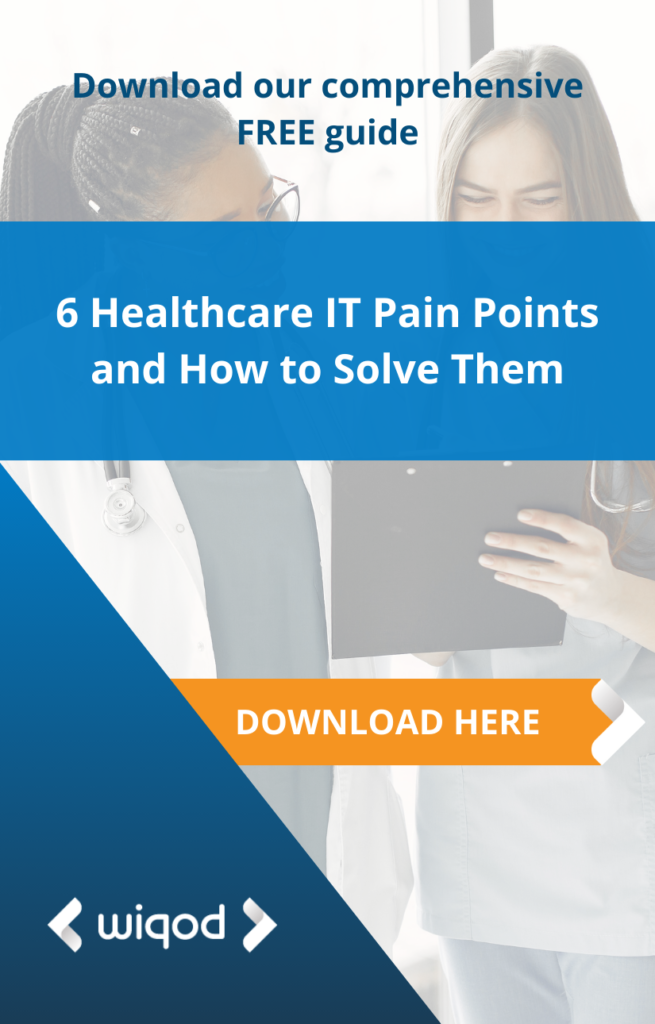Healthcare software development is a rapidly growing industry, with applications customized to cater to the diverse needs of healthcare organizations.
In this guide, we at Wiqod, drawing from our experience working with healthcare providers, will provide insights on identifying the medical systems that best suit your organization’s requirements. From patient management to billing and administrative functions, modern healthcare software encompasses a wide range of systems.
In this article, we will explore the various categories of healthcare software options and help you learn if you currently have the right software for your organization’s needs.
Understanding Healthcare Software Categories and their main features
There are four big categories into which we are going to divide healthcare software solutions. “Patient and Professional Management”, “Patient Care and Administration”, “Imaging and Medication” and “Financial and Administrative Functions”. Let’s dive into each category:
Patient and Professional Management
Effective management of patients and healthcare professionals is crucial for healthcare organizations. Healthcare software can offer you the following capabilities in this category:
- Identification and Record-Keeping of Patients and Professionals: Efficiently maintain patient and professional information, ensuring accurate identification and record-keeping.
- Benefits Definition and Application Process: Streamline the process of defining benefits and facilitate the application process for healthcare services.
- Shift Scheduling for Healthcare Workers: Optimize the allocation of shifts for healthcare workers, ensuring smooth operations and efficient staffing.
Patient Care and Administration
Efficient patient care and streamlined administrative processes are essential for healthcare organizations. Healthcare software provides the following functionalities:
- Admission and Discharge Processes: Automate and streamline the admission and discharge processes to enhance patient experience and operational efficiency.
- Billing and Insurance Claims Management: Simplify billing processes and effectively manage insurance claims, reducing errors and improving revenue management.
- Creation and Management of Patient Records: Digitize patient records, ensuring easy access, accurate documentation, and efficient management of patient information.
Imaging and Medication
Accurate imaging and medication management are critical components of healthcare organizations. Healthcare software can offer you the following capabilities in this category:
- Management of Image Files and Prescriptions: Efficiently store and manage image files and prescriptions, ensuring accessibility and accuracy for healthcare professionals.
- Radiology Workflow Automation: Automate the workflow processes in radiology, facilitating the storage, manipulation, and distribution of patient data and images.
- Picture Libraries for Efficient Storage and Retrieval of Medical Images: Efficiently store and retrieve medical images, such as X-rays, computed tomography, and magnetic resonance imaging, enhancing diagnostic processes.

Financial and Administrative Functions
Last but not least, effective financial and administrative management is vital for the success of healthcare organizations. Here are 3 capabilities that Healthcare software provides:
- Automated Medical Practice Billing and Accounting Procedures: Streamline medical practice billing and accounting processes, including accounts payable, accounts receivable, and financial reporting.
- Inventory Control, Asset Maintenance, and Human Resources Management: Efficiently manage inventory, assets, and human resources, ensuring smooth operations and optimal resource allocation.
- General Financial Reports and Administrative Processes: Generate comprehensive financial reports and streamline administrative processes such as invoicing, purchasing, and budget management.
Tailoring Healthcare Software to Specific Organizations
We have already analyzed the different categories and the specific solutions offered by software development for each one. In our years of experience in Wiqod, we have learned that not all organizations are the same. For this reason, we will now talk about the main types and the possible specific needs that each organization may have and how the software adapts to each of them.
Targeted Solutions for Different Healthcare Entities
Healthcare software providers offer targeted solutions for various healthcare entities, we divide it into 4 main categories. Of course, there are more, but we consider these ones to be the most common ones:
- Health Insurance Operators: Tailored software solutions to meet the unique requirements of health insurance operators, streamlining their processes and enhancing service delivery.
- Hospitals: Comprehensive software solutions designed to support the complex operations of hospitals, optimizing patient care, and administrative processes.
- Clinics: Specialized software solutions for clinics, enabling efficient patient management, appointment scheduling, and streamlined workflows.
- Laboratories: Software solutions specifically designed for laboratories, facilitating accurate test result management, sample tracking, and data analysis.
Choosing Between Independent and Integrated Systems
When selecting healthcare software, organizations must consider whether to implement independent applications for specific tasks or opt for a complete suite of tools. Additionally, organizations may need to replace existing practice systems with electronic health records (EHR) systems if they have not done it already:
- Implementing Specific Applications or Complete Suite of Tools: Determine whether specific applications or a comprehensive suite of tools best align with your organization’s needs and goals.
- Replacement of Existing Practice Systems with EHR Systems: Evaluate the benefits and challenges of replacing existing systems with electronic health records systems, considering data migration, training, and system integration.

Evaluating and Selecting Software Providers
Having already analyzed the different categories, the different types of organizations, and the specific solutions that software development offers for each one, it now remains to evaluate and choose the future or current software provider. These are the factors that at Wiqod we believe you should evaluate when choosing a provider:
- Financial Stability and Technological Strength of the Supplier: Choose a supplier with a solid financial position and up-to-date technology to ensure long-term support and system advancements.
- Size and Reputation of the Customer Base: Assess the size and reputation of the software provider’s customer base as an indication of their experience and market presence.
- Code Stability and Reputation of the Software: Ensure that the software has stable code and a good reputation for reliability, security, and performance.
- Availability of Distribution Channels and Customization Options: Evaluate the provider’s distribution channels and customization capabilities to ensure scalability and adaptability to your organization’s needs.
- User-Friendliness and Ease of Implementation: Consider the ease of use and implementation of the software, as well as the availability of training and support resources.
Over time you will develop a relationship and symbiosis with your software provider. Establishing a strong relationship with the software provider is crucial for long-term success. We consider it important that you analyze the following items when choosing or maintaining a relationship with your current developer:
- Importance of Evaluating the Supplier Company: Evaluate the supplier company’s expertise, reputation, and compatibility with your organization’s values and goals.
- Testing the Product During Development: Engage in the development process by testing the software with your colleagues to ensure its suitability and alignment with your organization’s requirements.
Nearshoring Healthcare Software Providers:
Software development nearshoring has emerged as a popular strategy in the healthcare industry, offering numerous advantages. With nearshoring providers, such as Wiqod, organizations can outsource their software development projects to nearby countries with similar time zones, cultural affinities, and lower costs. This approach enables close collaboration, seamless communication, and reduced travel expenses compared to offshore outsourcing.
Nearshoring also allows for better control over development processes, intellectual property protection, and adherence to regulatory requirements. By leveraging the benefits of software development nearshoring, healthcare organizations can access top-notch talent, accelerate project timelines, and achieve cost-effective solutions while maintaining high-quality standards. You can learn more about nearshoring in my previous article “Overcoming the Tech Crisis and Economic Uncertainty” by clicking here.

Final Thoughts
In conclusion, there is a wide range of healthcare software solutions available to meet the specific needs of different organizations. When choosing a software provider, it is important to evaluate factors such as financial stability, technological strength, size and reputation of the customer base, code stability, availability of distribution channels and customization options, user-friendliness, and ease of implementation.
Wiqod is a nearshoring healthcare software provider that offers a wide range of services for the Healthcare industry. If you are looking for a healthcare software provider, we encourage you to contact us to learn more about our services. We would be happy to discuss your specific needs and requirements. If you want to learn more about Wiqod services for the healthcare industry you can visit our site by clicking here.

